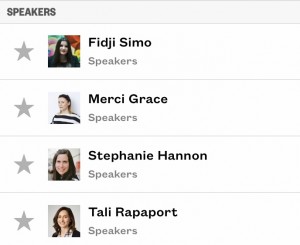 This session was the best thing I attended during the first day of SXSW Interactive. Slack, Lyft, Facebook and Google all have amazing products and I listened to a panel discussion with the women who are in charge of making sure these tech products remain relevant and useful. They covered many different topics about working with products and people in their respective organizations. Here’s my recap from the various themes that were discussed.
This session was the best thing I attended during the first day of SXSW Interactive. Slack, Lyft, Facebook and Google all have amazing products and I listened to a panel discussion with the women who are in charge of making sure these tech products remain relevant and useful. They covered many different topics about working with products and people in their respective organizations. Here’s my recap from the various themes that were discussed.
A Diverse Team Leads to Great Digital Products
A diverse team forces you to give up assumptions about the world and learn about people. In a diverse work environment you learn to be empathetic toward people who are not like you. This helps you build products or features for new users who may not know your product intimately.
 Data vs. Discovery
Data vs. Discovery
Data only goes so far. It can’t give you the idea of what to build. You have to go out and prove your opinion or objective right or wrong with users and testing in the real world. You must send people to the field to gain intuition.
Hillary Clinton Campaign engineers were sent door-to-door to canvas for primaries. They were setting up the process for taking in, processing and analyzing the canvasing results. Going into the field allowed them to find ways to optimize that process.
Speed vs. Polishing
There is often a balance between completing a project as fast as possible while also taking the time to make sure there are no bugs or issues. This really goes back to your company values and processes. Lyft believes in polishing the core. When you’re small certain things matter more, you must prioritize. Find the core hypothesis behind the product. Facebook Live has two core components, video and conversation. But adding things like drawing or masks just enhance the experience, which were launched later, to start all they needed was the live video and conversation components.
Hillary Clinton’s engineering team built over 100 digital products, including the fact checker during the debate and two different mobile applications. Because of the volume of users across the country, resiliency was the priority before polishing tons of features.
Disruption vs. Resources
Invest time and resources into disrupting yourself, especially if your idea is on mission for your brand. If you’re going to divert resources for something new, make sure it pays off in the end. Create priority lists every month and make sure you are using everything at your disposal correctly. This allows you to make sure resources are in the right place and legacy projects aren’t over resourced when it doesn’t make sense.
Managing Up
Managing up is not a skill anyone teaches. The best way to manage CEOs, executives and other superiors is to be transparent and consistent in your communication. Weekly meetings need to be consistent and if they’re changed it needs to be discussed why. Storytelling is a great characteristic in talking with superiors. People are story driven creatures. Framing conversations that way will help you clearly communicate objectives and goals as well as issues.
Failures Happen
Failures can be visceral. Take away what you learned. Maybe you were trying to do too many things at once? For new products if you do too much it can overwhelm people and hinder adoption. Always try to repurpose what you can. If you build something, especially in tech, you can take pieces and use them for something else.
Be honest about your failure. Many work cultures don’t embrace failure even if they say they do. This trains people to avoid risk and new opportunities. Don’t be afraid to keep failing! Maybe after the 3rd or 4th time, take a step back and evaluate any common factors.


